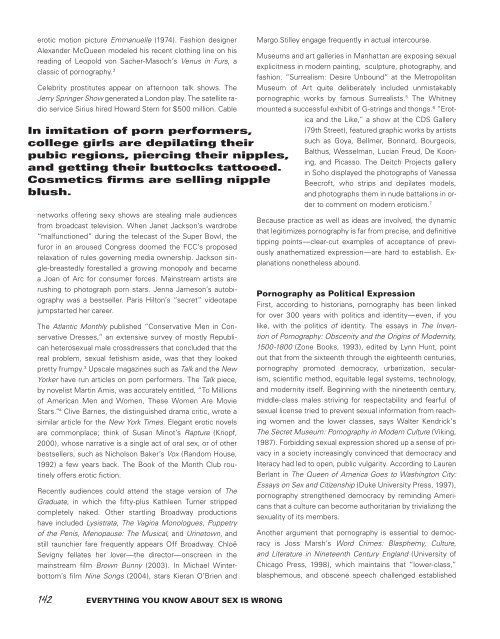Create successful ePaper yourself
Turn your PDF publications into a flip-book with our unique Google optimized e-Paper software.
erotic motion picture Emmanuelle (1974). Fashion designer<br />
Alexander McQueen modeled his recent clothing line on his<br />
reading of Leopold von Sacher-Masoch’s Venus in Furs, a<br />
classic of pornography. 2<br />
Celebrity prostitutes appear on afternoon talk shows. The<br />
Jerry Springer Show generated a London play. The satellite radio<br />
service Sirius hired Howard Stern for $500 million. Cable<br />
In imitation of porn performers,<br />
college girls are depilating their<br />
pubic regions, piercing their nipples,<br />
and getting their buttocks tattooed.<br />
Cosmetics firms are selling nipple<br />
blush.<br />
networks offering sexy shows are stealing male audiences<br />
from broadcast television. When Janet Jackson’s wardrobe<br />
“malfunctioned” during the telecast of the Super Bowl, the<br />
furor in an aroused Congress doomed the FCC’s proposed<br />
relaxation of rules governing media ownership. Jackson single-breastedly<br />
forestalled a growing monopoly and became<br />
a Joan of Arc for consumer forces. Mainstream artists are<br />
rushing to photograph porn stars. Jenna Jameson’s autobiography<br />
was a bestseller. Paris Hilton’s “secret” videotape<br />
jumpstarted her career.<br />
The Atlantic Monthly published “Conservative Men in Conservative<br />
Dresses,” an extensive survey of mostly Republican<br />
heterosexual male crossdressers that concluded that the<br />
real problem, sexual fetishism aside, was that they looked<br />
pretty frumpy. 3 Upscale magazines such as Talk and the New<br />
Yorker have run articles on porn performers. The Talk piece,<br />
by novelist Martin Amis, was accurately entitled, “To Millions<br />
of American Men and Women, These Women Are Movie<br />
Stars.” 4 Clive Barnes, the distinguished drama critic, wrote a<br />
similar article for the New York Times. Elegant erotic novels<br />
are commonplace; think of Susan Minot’s Rapture (Knopf,<br />
2000), whose narrative is a single act of oral sex, or of other<br />
bestsellers, such as Nicholson Baker’s Vox (Random House,<br />
1992) a few years back. The Book of the Month Club routinely<br />
offers erotic fiction.<br />
Recently audiences could attend the stage version of The<br />
Graduate, in which the fifty-plus Kathleen Turner stripped<br />
completely naked. Other startling Broadway productions<br />
have included Lysistrata, The Vagina Monologues, Puppetry<br />
of the Penis, Menopause: The Musical, and Urinetown, and<br />
still raunchier fare frequently appears Off Broadway. Chloë<br />
Sevigny fellates her lover—the director—onscreen in the<br />
mainstream film Brown Bunny (2003). In Michael Winterbottom’s<br />
film Nine Songs (2004), stars Kieran O’Brien and<br />
Margo Stilley engage frequently in actual intercourse.<br />
Museums and art galleries in Manhattan are exposing sexual<br />
explicitness in modern painting, sculpture, photography, and<br />
fashion. “Surrealism: Desire Unbound” at the Metropolitan<br />
Museum of Art quite deliberately included unmistakably<br />
pornographic works by famous Surrealists. 5 The Whitney<br />
mounted a successful exhibit of G-strings and thongs. 6 “Erotica<br />
and the Like,” a show at the CDS Gallery<br />
(79th Street), featured graphic works by artists<br />
such as Goya, Bellmer, Bonnard, Bourgeois,<br />
Balthus, Wesselman, Lucian Freud, De Kooning,<br />
and Picasso. The Deitch Projects gallery<br />
in Soho displayed the photographs of Vanessa<br />
Beecroft, who strips and depilates models,<br />
and photographs them in nude battalions in order<br />
to comment on modern eroticism. 7<br />
Because practice as well as ideas are involved, the dynamic<br />
that legitimizes pornography is far from precise, and definitive<br />
tipping points—clear-cut examples of acceptance of previously<br />
anathematized expression—are hard to establish. Explanations<br />
nonetheless abound.<br />
Pornography as Political Expression<br />
First, according to historians, pornography has been linked<br />
for over 300 years with politics and identity—even, if you<br />
like, with the politics of identity. The essays in The Invention<br />
of Pornography: Obscenity and the Origins of Modernity,<br />
1500-1800 (Zone Books, 1993), edited by Lynn Hunt, point<br />
out that from the sixteenth through the eighteenth centuries,<br />
pornography promoted democracy, urbanization, secularism,<br />
scientific method, equitable legal systems, technology,<br />
and modernity itself. Beginning with the nineteenth century,<br />
middle-class males striving for respectability and fearful of<br />
sexual license tried to prevent sexual information from reaching<br />
women and the lower classes, says Walter Kendrick’s<br />
The Secret Museum: Pornography in Modern Culture (Viking,<br />
1987). Forbidding sexual expression shored up a sense of privacy<br />
in a society increasingly convinced that democracy and<br />
literacy had led to open, public vulgarity. According to Lauren<br />
Berlant in The Queen of America Goes to Washington City:<br />
Essays on Sex and Citizenship (Duke University Press, 1997),<br />
pornography strengthened democracy by reminding Americans<br />
that a culture can become authoritarian by trivializing the<br />
sexuality of its members.<br />
Another argument that pornography is essential to democracy<br />
is Joss Marsh’s Word Crimes: Blasphemy, Culture,<br />
and Literature in Nineteenth Century England (University of<br />
Chicago Press, 1998), which maintains that “lower-class,”<br />
blasphemous, and obscene speech challenged established<br />
142 EVERYTHING YOU KNOW ABOUT SEX IS <strong>WRONG</strong>


